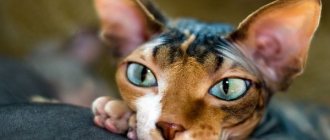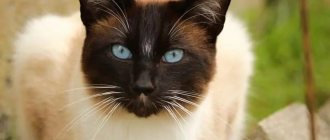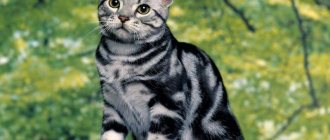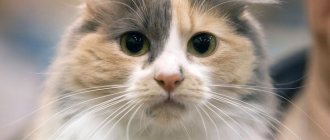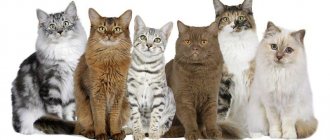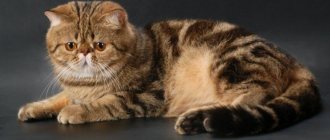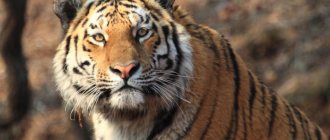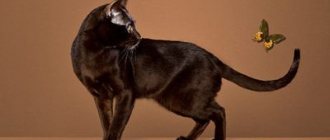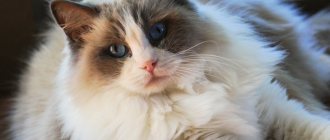Cats with big ears have become very popular recently. And the whole point is not that they hear and react better, but that they have an unusual appearance and peculiar beauty, which attracts so many people. Representatives of many breeds that are of high value have large ears. If you are planning to have a pet at home that has large ears, then you should first study all the types and characteristics of the breeds of big-eared cats and cats.
Big ears: why do cats need them?
Apart from some extravagance, large locators in cats are a useful and even necessary thing. Most cats have ears that are not perfectly proportional. And for good reason.
Oriental cat
The quality and acuity of the musk's hearing does not depend in any way on the size of the ears. In any case, the animal is able to hear prey at a great distance. For example, a furry huntress can smell the squeak of a mouse even at a distance of half a kilometer. At the same time, neither walls nor any other obstacles interfere with her.
And even in their sleep, cats are on alert. Even in a half-asleep state, Murka continually turns its locators towards the sounds occurring around it. It is interesting that in order to move the auricle in a cat, more than 30 muscles come into action.
But besides excellent hearing, there is another secret of big ears. This is heat transfer. Thanks to its ears, a cat can regulate its body temperature. And just cool down. For this reason, the true record holders for the largest “hearers” are the oriental breeds.
The hot climate of the east influenced the formation of rocks and gave the murks the opportunity not to overheat on particularly hot days. Blood passing through the thinnest blood vessels in the auricle is cooled due to the ambient temperature. In other words, cats literally “catch the wind.”
Ear diseases in cats
Hearing is a very important sense for felines. Their ears pick up the quietest rustles and sounds that are inaccessible to our perception.
Some scientists claim that a cat's hearing is more sensitive than that of the most alert dog. Despite the fact that the graceful creature lives with a person, her natural feelings are not dulled.
But this is only if the owner “monitors” the pet’s health.
The most common ear diseases in cats are:
Ear mites (otodectosis, ear scabies)
It is transmitted from cat to cat and is the most common cause of ear problems. The animal constantly shakes its head and scratches its ears, from which pus oozes.
Under the supervision of an experienced veterinarian, the disease can be treated, but it can take a long time (up to three weeks).
Microscopic mites in ear discharge can only be seen under a microscope, so if you suspect that your pet has “caught” this parasite, you should definitely show it to a veterinarian.
Signs may include an increase in ear size, drooping, swelling, and elevated temperature. If the problem is not solved, then over time the pain will only intensify, and the hematoma itself may become infected. This can lead to irreparable complications, including necrosis.
If there is a hematoma, the cat changes its behavior, it becomes aggressive (for example, when trying to pet it), constantly shakes its head, and scratches its ear. It is easy to cope with a hematoma. During the first 2 days of injury, the ears should be secured with a bandage and cold applied.
The symptoms of hematoma are also similar to lymphatic extravasation. Only in this case does fluid form (an accumulation of lymph flowing from the blood vessels), and treatment must be entrusted to a specialist. The fact is that the liquid needs to be pumped out, and this requires skills. Self-medication will only harm your pet.
Inflammatory processes (otitis media)
- The causes of otitis media in cats are varied: hypothermia, allergies, foreign bodies in the ear, infections, accumulation of wax, and more.
- Characteristic signs: loss of appetite, lethargy, head tilt towards the damaged ear, purulent discharge, the inner surface of the auricle turns red and becomes hot.
- A mild form of the disease can be easily treated with ordinary ear drops, which can be purchased at any veterinary kiosk. In advanced cases, treatment and observation by a veterinarian is necessary.
Necrosis
- Necrosis is the death of ear tissue. This can occur with prolonged squeezing of the ear, the development of purulent processes, abscesses and infection.
- As a result, large ulcers appear on the ears, the ear cartilage becomes visible and blackened, and a characteristic rotten smell appears. The ear is noticeably deformed.
- Treatment is carried out only surgically, up to amputation of the auricle. The process should not be allowed to reach the inner ear.
Prevention of ear diseases in cats
As you know, any disease is easier to prevent than to treat. This postulate fully applies to ear diseases in cats. Do not forget to regularly care for the ears of your four-legged ward, provide him with a balanced diet and regularly visit the veterinarian.
Read with this
- My gentle and affectionate cat: 15 breeds
- An expression of love or a way to relax: why do cats purr?
- Why do cats bury food? Why do cats bury food next to the water bowl after they eat? why do cats do this every time?
- How to choose a cat breed
- Why does a cat need a tail?
- Your cat's strange behavior: how to decipher it
- How long do cats sleep per day?
- The biggest cats in the world
- Havana
- How to pet a cat correctly
Siamese
Siamese cats and cats not only have a beautiful appearance, but also unusual large ears.
They are popular members of the cat family that many people keep at home. It is worth noting! Old-style Siamese are endowed with round shapes and stocky builds. But animals that were bred not so long ago received a long, muscular body with elongated legs and a tail.
A common feature that unites cats of this breed is the presence of beautiful large ears with a wide fit. They are triangular in shape with pointed ends.
The coat is smooth and soft to the touch. The fur color is unusual with characteristic stripes and spots. True representatives of the Siamese breed always have dark markings on the face, paws and on the surface of the tail, mainly at the tip.
According to numerous studies, Siamese are the progenitors of many cat breeds. That is why they behave with grace, importance and dignity. They have a loud voice. For this reason, in the houses where these particular animals live, it is never quiet and calm.
Savannah
The Savannah is a relatively new breed, having been developed in the 1980s. Representatives of this breed are similar to cheetahs. Savannah is obtained by crossing a serval and a domestic cat. These cats are divided into four groups, depending on the degree of relationship with the wild parent.
- F1 are kittens that were born directly from crossing a serval and a domestic cat. They are considered semi-wild, but they are quite easy to tame and accustom to domestic life. Savannahs of group F1 are the largest representatives of the breed; they can reach 12 kg and 55 cm at the withers.
- F2 - less wild kittens, considered a quarter serval. They are obtained when an F1 female and an F5 male or subsequent generations are brought together. This cat is smaller, growing up to 10 kg and 45 cm at the withers.
- F3 - cats of this group are already more similar to domestic ones in size, they can reach 8 kg and 40 cm at the withers. They are obtained by crossing an F2 female and a male of the fifth or subsequent generations. Their degree of “servalism” is a little more than a tenth.
- F4 - only 6% serval, this cat is obtained by crossing a female of the third and a male of the fifth or subsequent generations. These are the smallest Savannahs - up to 6 kg and 35 cm at the withers.
The further away from the wild ancestor, the more calm, homely disposition the savannah has. Moreover, the greater the proportion of Serval blood, the more expensive the Savannah kitten will cost the new owner.
The Savannah breed is divided into 4 groups depending on the degree of relationship with wild ancestors.
Characteristics
Appearance. Savannah looks like a wild cat - large, with a well-built muscular body, a short tail, long and strong legs, a long neck and large ears. The coat is short and does not require much grooming. The Savannah has a bright yellow coat with black spots, but sometimes black animals are also found.
Character. Despite the close relationship with the wild cat, savannas have a quite docile character. In order for the kittens to have the qualities of a domestic cat, the Serval parent must also be accustomed to people and not be afraid of them. Therefore, it is important to choose a responsible breeder who understands all the intricacies of breeding this breed.
Savannahs are very intelligent and form strong bonds with their owners. When getting such a cat, you need to remember the need to educate it; this requires time and patience. To avoid possible aggression (genetically determined), Savannah kittens need to be socialized. Again, in this matter, the work of the breeder is important, who accustoms the kittens to the human way of life from the first days.
Savannahs are active cats and need space for play and physical activity. These cats are easy to train to use a harness. Walking can help provide adequate exercise.
Savannah can be trained to wear a harness and be walked with like a dog.
Health. Savannahs are prone to hypertrophic cardiomyopathy. This is a disease in which the wall of the left ventricle thickens.
Cats with this pedigree have special nutritional needs. Savannahs, as close descendants of the wild cat of prey, are recommended a raw, species-typical diet. If you are thinking of keeping such a predator at home, we recommend that you think about the diet - SUPERPET is perfect for these animals.
Ukrainian Levkoy
This young cat breed with large ears and a long nose was bred in Ukraine in 2004. The stretched, muscular body of the left-wing is covered with hairless folded skin that requires careful care.
But the main feature of the animal is not its bald skin, but its large ears with drooping tips. They are located at the very top of the head and have a wide set.
The big-eared Ukrainian Levkoy is endowed with a non-conflict, good-natured disposition. He doesn't hold grudges and never shows character. This hairless cat with large ears and a long muzzle quickly becomes attached to his owners and needs constant communication with people.
Maine Coons
The origin of this cat is surrounded by myths: they claim that the breed was obtained by crossing a cat and a lynx. But that's not true. Initially, the breed was very common in Maine. Severe snowy winters have led to the appearance of cats with thick, long hair, large paws and tufted ears.
The Maine Coon breed gets along well with people, but is not overly tame. They are moderately sociable, calm, and in their youth they prefer to climb trees. Coons inherited a passion for hunting from their ancestors, and kittens of this breed love to play with balls and toy mice.\
Elf
By crossing the American Curl and the Canadian Sphynx, breeders managed to obtain a wonderful variety of hairless cat breeds called the Elf.
She took the best qualities from her parents and quickly gained high popularity. The expressive qualities of the Elf include the following features:
- cats have small body sizes, which are well developed and correct proportions;
- true representatives of the Elves have a characteristic feature - a slightly protruding belly of a small size;
- endowed with large and protruding ears, the tips of which are slightly bent back;
- Cats have no fur at all, and they also often have no whiskers or eyebrows. The skin feels like soft velvet to the touch.
Pets require special care. They are very afraid of drafts, for this reason it is important to ensure that the room is always warm. In windy weather, it is better to leave the cat at home, otherwise it may get blown out and get sick. In winter, animals need to be dressed warmly. Since Murka likes to constantly stay near the window, it is advisable to properly insulate the window sill and window frame.
Angora
The Angora cat has a second name - Turkish, which is why they are often called Turkish Angora. Representatives of the cat family of this breed originated in the East, but at the same time they are highly popular all over the world, including Russia.
The main features of the Turkish Angora include the following:
- these are beautiful cats with fluffy and snow-white fur, which becomes softer and snow-white with age;
- the body is large, quite flexible, elongated and plastic;
- The main distinguishing feature of the Turkish Angora is its blue eyes. Large and round eyes can have different shades, for example, green and blue;
- neatly shaped muzzle with cute features;
- The ears are large, they stand upright, and there may be thick tufts of white wool at the tips.
Turkish Angora is the embodiment of comfort and warmth. They love affection very much and do not tolerate loneliness. They make an excellent friend for singles, they quickly become attached to their owner and remain faithful until the end of their lives.
Cats with big ears are beautiful and affectionate animals that attract people with their grace and elegance. They are ideal for living in an apartment, private house or cottage. Basically, representatives of the cat family have an unpretentious, affectionate and friendly character. They quickly become attached to their owner and do not tolerate loneliness. But before you get these animals, you should study their main features and maintenance rules.
Somalia
The ancestor of the Somali cat, “wearing” large ears, is considered to be the Abyssinian. The breed is named after the neighboring country – Somalia. The breed received its calling in 1991. Distinctive features are: thick fluffy fur of a reddish color, white chest, large ears. With this characteristic, one can compare Somalia to a cunning fox. The breed standards are the same for Abyssinians and Somalis, only the length of the coat differs.
Somalia will be a devoted and affectionate friend, will not let you sit still, demanding frequent and lively games. The “big ears” cat loves various heights, so it can often walk along the closet, refrigerator, or back of the sofa. Does not require special care: brushing with a medium-hard or soft brush once a week, washing once a month, weekly ear cleaning. When feeding, use food that is high in protein but low in fat. This way the cat will have a fit, sporty look.
The undercoat is expressive, slightly lighter than the skin, the color takes a long time to develop. The cat has cute arrows in the corners of its eyes and rounded ears. Life expectancy is up to 16 years.
Oriental cat
This oriental cat has been paving the way to her celebrity for a long time. Thailand is considered the birthplace of the breed. For a long time, the country prohibited the travel of these cats abroad. But in the 19th century, Orientals came to London. At the exhibition, the breed failed twice - the jury did not want to recognize the “non-Siamese” color. In 1974, Orientals were registered as an official breed thanks to the efforts of Baroness Edith.
© shutterstock
The structure of the body is characterized by smoothness, refined curves, and the body is graceful. Distinctive features are also:
- head in the shape of a regular triangle;
- long, but not turned up nose;
- large rounded ears that grow up to three months;
- almond-shaped eyes green or blue;
- thin long tail.
It's amazing that Orientals have up to 300 types of colors. Moreover, all kittens in a litter can be of different colors. Cats are the owners of a ringing voice, which they are ready to demonstrate every minute. Protect your plants from kittens, as these curious lumps, already with large ears, are very playful and poke their noses everywhere. It should be remembered that for all their friendliness and activity, Orientals are touchy.
Cats' nails tend to grow quickly, so they need to be trimmed regularly. These fidgets love to eat, but do not overfeed them, otherwise you risk getting a voracious bun instead of an elegant cat. With proper care, Orientals live up to 20 years and become strongly attached to their first owner. This cat needs to be adopted for the rest of its life!
Devon Rex and Cornish Rex
Cats of these two breeds also have large ears. England became the birthplace of the Devonian. The breed quickly managed to conquer all of Europe, but with America it turned out to be more difficult. It took 20 years to gain popularity in the USA. Only after this did the proud Americans give in and accept such an eccentric breed, whose representatives wore large ears.
These mysterious animals have wide-set ears, sometimes with tassels, a slightly upturned capricious nose, and eyes of yellow, green and blue shades . A cute feature of the breed is its thick and curled mustache and eyebrows. The cats are stocky in structure, have a fairly powerful chest and long, thin legs. Devons' fur is short, but soft and slightly wavy, like a lamb's.
Devon combines a cat's appearance and a big, ardent love for his owner, like a dog's. Surprisingly, these cats, which have large ears, can be taught simple commands and are highly trainable from an early age, even as kittens. Such “elves” live up to 17 years.
Cornish has a wedge-shaped head, his cheekbones are clearly visible. The nose is straight and the ears are set high, wide at the base and pointed at the tips. The Cornish's tail is very long and flexible. The coat is soft, short and wavy, like an astrakhan fur coat.
This muzzle with large ears is distinguished by intelligence, becomes attached to the owner, and not to its habitat, and loves to eat, so watch your pet’s diet. It is practical that males do not mark territory. Cats that “wear” large ears are happy to walk on a leash, tolerate traveling in a bag well and can boast of a long life - up to 20 years.
© shutterstock
Canadian Sphynx
This owner of smooth, hairless skin, with folds not only on his tummy, but throughout his body, instantly attracts attention. The first kitten of this breed was born in Canada in 1966 and had large ears. But stability in a bald appearance was achieved over the course of 10 years. The first Canadian Sphynxes were sent to Holland, where they laid the foundation for the beautiful breed.
There are only 3 breeds of hairless cats in the world: Canadian, Don and Pereburg Sphynxes. What makes a Canadian special?
Character traits:
- Wedge-shaped head, prominent cheekbones, strong jaws.
- A wide bridge of the nose, but at the same time a short nose, covered with light fur, like the lips.
- Widely spaced ears, large, may have pubescence, but tassels are not allowed in the standard.
- Kittens become sighted very early, they surprise with their large eyes, their color should be in harmony with their color.
- The antennae are almost invisible and may be completely absent.
- The gait is graceful and elegant, there are long toes on the paws, the hind legs are longer than the front ones.
- The tail is long, looks like a whip, and may have a small tassel at the end, like a lion cub. The tail is most often curled up and pressed against the cat's body.
One of the fun facts is that the Canadian Sphynx seems very light, but when you pick it up in your hands, you will feel the considerable weight of the carcass, which has large ears. Cats are very loving, get along well with animals, very loyal creatures - always ready to entertain their owner. Such charming creatures live on average up to 15 years.
Maine Coon
The birthplace of this cat is the northwestern town of the USA - Maine. There are absolutely funny legends about the origin of the breed: some suggest that the Maine originated from a raccoon and a cat, or a lynx and a cat. But these are just fancy tales.
The cat's long hair and large ears were formed due to the climate . These cats needed to adapt to cold, snowy winters, and besides, Maines were excellent hunters with soft gait and very sensitive hearing.
Already at birth, kittens differ from the cubs of other cats in their large size and thick, warm fur. The cat's head is not elongated in length as usual, but in width. The skull is quite massive, the cheekbones are set high, the ears are triangular in shape with lush tassels.
The oval eyes are set quite wide apart, the body is muscular and large. Maines should have tufts of fur between their toes; the coon's tail is large and fluffy. Such “heroes” weigh up to 16 kilograms.
Despite their large size, Maine Coons are very playful, constantly curious, friendly towards others, and love affection and tenderness. Cats of this breed take a long time to grow - the body can be fully formed over the course of 5 years.
Maines love to climb trees, especially as kittens. For what? They like to be on top, so the view becomes wider . As cats age, they become less active and lazily look around at those around them, but nothing can hide from their prying eyes. If the cat sees something interesting, the warm place will be immediately abandoned. Maine Coon ears need to be cleaned regularly.
© shutterstock
Cats of this breed have pride and self-dignity - they will never beg for food or try to steal it from the table. Coons have an interesting manner of “speech” and live up to 20 years.
Balinese (Balinese cat)
Another breed with large ears, which is related to the Siamese cat, therefore has a similar appearance to it and at the same time is practically not similar in character. Kittens are born completely snow-white and only with age acquire a characteristic color. Balinese are very fond of affection and tenderness, they have a playful character, but they do not tolerate being offended: even if it is a child, scratches and aggression cannot be avoided.
Prices for Balinese kittens range from 5,000-15,000 thousand rubles.
Features of these cats
The special shape of the head is called brachycephalic, as mentioned above. In fact, this phenomenon is a pathology.
According to scientists, the pathology is inherited from wild Pallas' cats, in which a similar head shape is found in nature. All representatives of cat breeds with a flat nose have a wide head (the width is more than 80% of the height).
Pros of breeds:
- Such cats look truly unusual, even in the present age, when people are accustomed to meeting purebred animals with brachycephaly;
- The jaws of cats with a flattened skull structure are much stronger than those of ordinary breeds;
- All cats of these breeds demonstrate an affectionate, friendly character and calm behavior in everyday life.
Flaws:
- The unusual shape of the skull results in noisy sleeping, eating, snorting and snoring;
- Shortened tear ducts and a special shape of the nose lead to increased secretions during stress or exposure to cold;
- Some breeds cannot eat their own food; owners spoon-feed such cats.
This is interesting! The special shape of the head in cats is called a doll head. The naive, childish expression on the faces of these breeds of cats seems to some to be an expression of malice or aggression.
Persian cat
At the beginning of the 2000s, Persian cats were the most popular in the world. Now the popularity of the breed has subsided, but Persian cats are still the most prominent representative of brachycephaly.
Persians have a medium body size, long legs, and fluffy fur. In some individuals, the nose is almost in the same plane as the eyes. Despite their apparent kindness and harmlessness, Persian cats are very strong.
The price of a purebred Persian starts from 2 thousand rubles.
Important! Persian cats should not be allowed outside for independent walks. Brachycephalics need constant supervision and are helpless in front of the outside world.
There is a subspecies of the Persian breed - Himalayan cats. Not all associations recognize the breed. The Himalayan is registered as a Persian breed. Himalayan leather originated from Persians crossed with Siamese. The breed has the color of a Siamese cat and a characteristic face with brachycephaly.
Exocats
The Exotic Shorthair is a breed created by chance. In an attempt to lengthen the coat of the short-haired American breed, the individual was crossed with a Persian. The result was an exotic shorthaired cat. Now this breed is independent, has a flattened face and fluffy, short hair.
The breed has a prominent forehead, a stocky body and strong short legs. The shape of the head is extreme, i.e. eyes and nose are at the same level.
Representatives of an exotic breed of cats cost from 7 thousand rubles in the CIS countries.
Scottish Fold
The Scottish Fold breed has gained popularity due to its triangular, bent ears. Scottish fold cats reach a weight of 6 kg and have a strong, rounded body. These cats have a flattened muzzle, although the convexity of the nose is much greater than in previous breeds.
Some representatives of the breed straighten their ears with age. They are classified as a different breed - Scottish Straight. According to the canons, only straight-eared pets can be crossed with fold-eared ones. Crossing two lop-eared individuals leads to genetic mutations and diseases in the offspring.
Cats without a pedigree of the Scottish Fold breed cost from 3 thousand rubles.
Important! At shows, Scottish Folds may be disqualified for having too large a tail and hind legs. Recently, such a structure has been considered a disadvantage of the animal.
British Shorthair
Looking at the photo of the British man, it is impossible not to fall in love. These are amazingly beautiful brachycephals with short, smoky hair. British Shorthair cats are very smart and have the mentality of real English aristocrats.
The British have muzzles that are elongated enough for the cat to feed on its own and avoid the problems that Persians have. However, some form of brachycephaly is present in British cats.
The average price for a British Shorthair kitten is 10 thousand rubles.
In the wild, a flat muzzle is characteristic of only one member of the cat family - the Pallas's cat.
This is a rare species listed in the Red Book. The flattened shape of the skull is due to the need to hunt specific prey and carry it to its lair.
Domestic cats with a flattened muzzle almost do not resemble the ancestor of the Pallas' cat in appearance.
Kanaani
And another pet with an extremely expressive wild appearance and large ears. Kanaani is an animal with a powerful body and a bright leopard color. He is fully socialized to be kept indoors and to live with people.
Like any other domestic cat, this small leopard needs periodic water treatments and vaccinations. Perhaps the only thing potential Kanaani owners should know about is the need for walks in the fresh air. This cat will happily walk on a leash and explore its surroundings with curiosity.
Kanaani has a special character. They:
- freedom-loving;
- have serious hunting skills;
- flexible;
- loyal.
However, finding a common language with her is quite difficult. But, as practice shows, patient and loving owners still manage to turn this rather wayward animal into an affectionate pet and a reliable friend.
Kanaani are attracted by their unpretentiousness in nutrition and care
So how can we give up a cat with big ears now? Moreover, the choice is more than great. Among these beauties there are wild, wayward natures, and those who are ready to become your most devoted friend.
Content Rules
How to keep a cat with large ears depends solely on the breed to which it belongs. If you become the proud owner of a Turkish Angora, you will have to regularly comb out its luxurious fur with a slicker brush, and after that still clean horizontal and vertical surfaces from the consequences of its presence. If you have a Savannah or a beautiful Abyssinian galloping around your house, know that everything that is possible will be pulled out and studied from every corner of the house, so make sure that there are no beads or sharp objects in its access area.
Carefully consider the diet for your pet, consult a veterinarian. Get all the necessary vaccinations according to the schedule, and then be sure to take your cat for a preventive examination at least once every 6 months. If your cat walks outside, be sure to take timely anti-tick and anti-parasitic measures. If it is possible to purchase and put a tick collar on your animal, do so.
At home, a cat should have its own place to play, sleep and eat. Clean drinking water should always be available. Take care of a hygienic area where the cat can calmly go about his big and small business without disturbing family members.
If his tray is installed in the toilet, provide him with free access there; the door should not be tightly closed so that the cat cannot get into the room.
For safety reasons, install screens on your windows, especially in the summer. Get rid of the habit of throwing windows wide open, because cats do not always measure the height from which they fall, and often suffer from this. Do not leave your pet alone for a long time; they get very bored when they are alone. And, bored, they may become offended and arrange a “surprise” for their owner when he returns.
To find out what breeds of cats with big ears there are, see the following video.
https://kot-pes.com/koshki-s-bolshimi-ushami/https://petszona.ru/ushasty-e-porody-koshek/https://vplate.ru/koshki/s-bolshimi-ushami/
Eared record holders
Abyssinian
The Abyssinian was and will be one of the brightest eared record holders. Beautiful and strong, this cat remains cheerful in any weather. Thanks to huge locators, Murka feels good even in the most exhausting heat.
Abyssinian
Not many cats can boast such an original appearance. The Abyssinian breed is distinguished by its oriental “shroud” coloring, strong build and cat-like “makeup” - black eyeliner. The exterior is complemented by the famous ears: wide-set and large.
The cat itself is strong and muscular, its legs are long, its paws are neat. A special feature of the Abyssinian is the absolute inability to remain in place for more than a minute. This is a lively pet, active and playful.
Somalia
Descendant of the Abyssinian breed. Murka has medium-length fur, neat shape and, of course, beautiful ears.
The Somali cat is a real beauty. Her main “trump card” is a luxurious fur coat. This fur is reddish. A special feature of the fur coat is ticking (each fur has stripes of a different shade). The unusual color is complemented by a chic collar and wonderful pants. The whole outfit creates an extremely elegant image of a domestic predator.
In addition to the “suit,” the cat is distinguished by a neat physique and graceful gait. The Somali cat is the embodiment of grace and charm. And her character is so versatile and delightful that having met such a cat, you can hardly resist falling in love.
Oriental breed
Oriental cats are special. This applies to both appearance and character. This Murka comes from the east. Having become the progenitor of many modern cat breeds, the Oriental is a representative of the most remarkable qualities that nature could endow with independent cats.
This is a very friendly breed. The devotion of Orientals is legendary. Many people compare the temperament of these cats to that of a dog. And for good reason. Having chosen an owner, the oriental cat will be faithful to him in any matter.
Oriental cats have a bright appearance. Many people underestimate the exterior of these cats, considering them too clumsy in appearance. And in vain. The elongated body of the Oriental is very flexible and graceful. Long limbs are dexterous like a cat.
Eared Oriental
The ears of the Oriental deserve special attention. The breed standard clearly outlines the traits that should be present in the locators of a purebred cat. The ears should be pointed, triangular, and their line should continue the line of the cheekbones.
Devon Rex
The eared record holder is the Devon Rex. The first thing that catches your eye when looking at this pet is its ears. They are really huge. The wide base of the shell ends in a rounded tip. The ears are set relatively close to each other, but due to their size, the locators look almost to the sides.
Devon rex
The Devon Rex is often compared to a feline alien. He is so different from other cats. In addition to prominent ears, the Rex has large, expressive eyes. The “smile” complements the already curious mustachioed muzzle.
These cats come in a wide variety of colors. However, there is relatively little wool itself. At some time these cats can be almost hairless. Later, the fur coat grows back with a vengeance.
Wild spotted cats
Patterned coloring is characteristic of most predators. The most interesting of them are:
- Leopards. These animals are common in South Asia and almost the entire African continent, except the Sahara. Their weight rarely exceeds 75 kg. They are not picky about food and do not disdain carrion. Their body is covered with small round or almost square spots. They can be located individually or assembled in the form of sockets.
- Jaguars. These large predatory spotted cats live in South and North America. They weigh about 150 kg, but such dimensions do not prevent them from moving quickly, skillfully climbing trees and making huge jumps. The prey of predatory spotted cats is often larger and stronger animals. And sometimes even alligators end up in the teeth of jaguars. The black spots on their coat are irregularly shaped rings with dots inside.
- Snow leopards. The number of these beautifully colored animals is negligible, so they are listed in the Red Book. The light gray thick fur of snow leopards is covered with contrasting black spots.
- Cheetahs. These fleet-footed animals are capable of incredible speed. Their bodies are ideally adapted to the chase, their fur is covered with a smooth, elastic spine of spotted color.
- Fishing cats. These animals visually resemble Asian and American cats and live in the forests of Southeast Asia. They settle near small bodies of water and are masterful fishers. Their fur is grayish-brown in color with black spots and has water-repellent properties.
- Ocelots. These owners of short hair with large ring-shaped spots weigh between 7-15 kg. Ocelots are recognized as the most beautiful medium-sized cats in America. Kittens living near people grow up tame and social. The most famous pet ocelot, Babu, belonged to Salvador Dali and posed with his famous owner more than once.
- Servals. These wild African spotted cats have an unusual appearance and a luxurious coat. The colors of servals depend on their habitat. Individuals living in open areas have a light skin with large contrasting spots. Forest-dwelling servals have a darker speckled color.
Spotted cat - serval
The wildest and largest breeds with large ears
Savannah
This American woman with a wild but incredibly attractive appearance knows how to conquer. She looks like a small cheetah, but at the same time she is a domestic cat, very desirable for many. But since it is rare and expensive, not everyone can afford such a pet. A characteristic feature of this breed is its wild color and stunning grace. And all this with quite impressive sizes - adult individuals reach a height of 0.4 m, and their weight can be 15 kg. Their body is athletic with a powerful chest, strong hips and shoulders. On a relatively small head there are large ears, and at the base they are so wide that the distance between them is usually minimal.
What is the character of this wild-eyed mini-cheetah? Home Savannah:
- smart;
- inventive;
- sociable;
- inquisitive;
- prefers to be a leader.
On a note! Animals marked F1 (the first generation, which inherited 50% of the serval) will not become affectionate and cute pets. It is recommended to keep them in enclosures. Although there are exceptions!
Savannah, due to its common character with dogs, has a special affection for them
Serengeti
These cats are very similar in appearance to the Savannah, but the origins of the first and second are different. The Serengeti is a hybrid of a Bengal and an Oriental with the color and look of a real predator.
This is a breed of cat with large, high-protruding ears that occupy a significant portion of the head. The short and smooth fur of these animals has a beautiful spotted pattern, and their small emerald or honey eyes are truly mesmerizing. Cats of the Serengeti breed are large and heavy, and therefore will certainly appeal to all fans of the savannah.
Their character and habits can be described as follows:
- they like to play much more than to hunt;
- quite curious;
- talkative and at the same time, in addition to meowing, they are able to produce a large number of other sounds;
- dexterous;
- brave.
This is interesting! If a dog suddenly appears on the way near the Serengeti, the cat will not run away, moreover, it will begin to attack first!
Serengeti - the most fearless cat
Maine Coon
Unlike other breeds, the pointed ears of Maine Coons, which are located on the very top of the head, are decorated with “tassels”. They are giants in the pet world with long, thick hair that can weigh up to 15 kg. Despite their size, they are distinguished by a calm, friendly character and never release their claws without a serious reason. Maine Coons have a favorable attitude towards water, and they also love to dip their paws in a bowl of water before drinking.
The average price of Maine Coon kittens is 15,000-50,000 rubles.
Oriental
The Oriental also has an atypical appearance. It can be recognized by its long thin neck, the characteristic shape of its head and ears, which give it a slightly brutal appearance. But appearances are deceiving, Orientals are very attached to their owners, they are not at all aggressive. The most that can be expected from him is a hiss in response to irritation. If you treat an animal with respect, it will become a devoted friend, moreover, a true family member.
The most popular hybrid spotted cat breeds
Many owners of tabby color were born by crossing domestic and wild individuals. Although usually such mestizos are quite viable, occasionally they are diagnosed with any pathologies or infertility.
The most popular hybrid spotted cat breeds include:
- Bengal;
- toyger;
- savannah;
- Serengeti.
Bengal
These spotted cats are descendants of Asian leopards and domestic cats. They received official status as an independent breed in 1991.
Bengals are medium-sized spotted cats with a bright, memorable appearance. On a small head with pronounced whisker pads, high cheekbones and wide-set ears, there are oval or round slanted eyes with a “predatory” look.
The Bengal's muscular body is covered with smooth, silky, shiny coat with spots. The dark markings can be regular or in the form of a rosette resembling a donut, a paw print or an arrow.
The spots on the body of a cat of this breed contrast sharply with the main brown, silver or snowy background. Stroke is encouraged around the eyes and nose.
These spotted cats have a curious and friendly disposition. Playful and active Bengals get along well with other pets and do not show aggression towards people.
Toyger
Spotted cats, whose name comes from two English words: toy - toy and tiger - tiger, were bred in the USA in the 80s of the last century. They are descendants of Bengals and are still considered a developing breed.
The toyger looks like a smaller copy of a wild animal. Its proportionate, compact body is covered with short, dense, tabby-spotted fur.
Toygers have a sociable and playful disposition. Beautiful spotted cats are easy to train and have no problems getting along with other pets.
Savannah
This breed appeared in 1986 as a result of crossing a serval with a regular cat. In some American states, Savannahs are not only not recognized, but are also prohibited from keeping at home. According to local authorities, hybrid animals are very unpredictable and can lead to an imbalance in the ecosystem.
Savannah is a large spotted cat that can weigh up to 15 kg. The small triangular head has expressive eyes of copper, green or yellow.
The main distinguishing feature of the Savannah is its large, rounded ears with a pronounced pattern. Each of them has a so-called wild spot. The body of the Savannah is covered with short hair of silver, brown, golden or chocolate color with black or dark brown markings.
These spotted cats are endowed with an active and playful character. Smart and curious Savannahs quickly become attached to their owners and live peacefully with other pets.
Serengeti
This spotted cat appeared as a result of targeted breeding work by American geneticist Karen Sauzman, who wanted to get a breed similar to a serval. Bengals and Orientals were used to breed it.
The breed got its name in honor of the African national park of the same name, where many servals live.
The Serengeti is a large, long-legged cat with a wedge-shaped head and large eyes of light green, brown, yellow or honey. The animal's graceful, muscular body is covered with short, stiff, close-fitting, spotted fur.
Serengeti are sociable and responsive animals that take a long time to get used to humans. These spotted cats are fearless and curious. Therefore, they cannot be allowed out into the street without the accompaniment of their owners.
Velvet
Cornish Rex
A refined figure, short curly hair and beautiful large ears - by these signs you can recognize the representative of the Cornish Rex. In some places the fur is so short that the silhouette of the cat can be mistaken for a Sphinx. The advantage of this breed is that they practically do not shed, that is, they do not need to be combed or washed in any way. Features of care:
- Large ears require weekly cleaning.
- The paws of these cats are designed in such a way that they cannot hide their claws in the pads, so the claws also need to be trimmed often.
The character of the Cornish Rex is rather intelligent, they are well-mannered, keep themselves and their sleeping place clean and never go past the litter box.
Canadian Sphynx
These cats with more than extraordinary appearance managed to win the hearts of a huge number of people. Sphynx cats have a somewhat rounded body with a wide chest and round belly. The front legs are set wide apart and their tail is long and thin. The well-defined muzzle has prominent whiskers, expressive lemon-shaped eyes and very large, wide-set ears with rounded tips. They have smooth skin with numerous folds on the forehead, neck and limbs, while the body can be completely bald or have the finest, almost invisible fluff.
But not every hairless cat will be a Sphynx. Representatives of this breed have exceptionally soft outlines and a magical appearance. There are no straight lines in the figure, everything is rounded and convex, and the lines are only fluid and smooth.
The character of the Canadian Sphynx is also captivating. These pets usually:
- good-natured;
- peaceful;
- are not afraid of dogs;
- easy to train;
- very attached to people.
The Canadian Sphynx is a cat with a naked hot body and a special character
Advantages and disadvantages
The positive qualities of an animal include its character: the cat has a calm disposition and is friendly. The Scotsman is hospitable and treats people with respect.
The Scots, thanks to their extraordinary intelligence, are easy to train; their courage allows the animals to perform at various exhibitions. A cat can be taught to give a paw, walk on its hind legs, and perform simple tricks.
Fold cats easily learn to use the litter box and tolerate water treatments. Some individuals happily swim in open water sources.
One of the disadvantages is the price of the breed. If you are going to purchase a purebred animal, you will have to shell out an amount of up to 40 thousand rubles. Cats without a pedigree are much cheaper, about 4 thousand rubles, but this does not guarantee that they will sell you a Scotsman and not an animal with surgery performed on the ears. Moreover, such individuals may experience serious health problems in the future.
Other disadvantages include the health of purebred cats. Some Scots suffer from osteochondroplasia. This is a hereditary disease associated with damage to the bone tissue of the joints, cartilage, and manifests itself as a slowdown in bone growth. This disease can be fatal.
Other common diseases of Scottish Folds: chondrodystrophy, arthritis, arthrosis. These diseases usually occur due to improper mating of animals. Therefore, before buying an animal, you should carefully study the pedigree of the animal, right down to the cat’s ancestors. Scots may also suffer from entropion. Adult animals are susceptible to the development of glaucoma and cataracts.
Like all animals, the fold-eared breed may show signs of allergies, mange, or skin eczema. Deafness is also an eternal companion of the breed; it can be complete or partial. Diseases of the cardiovascular and digestive systems, and the bladder develop in old animals or when the cat is not properly cared for.
Rare and non-standard breeds
Poodle cat
These curly cats with large ears appeared quite recently and have not yet become popular. Their curly coat makes them resemble a poodle. Representatives of the breed are not only straight-eared, but also lop-eared. These unusual cats have a friendly and easy-going disposition.
Long-eared poodle cats easily adapt to any conditions and tolerate loneliness well.
Havana
The breed, called Havana Brown, was developed in the UK by crossing a Siamese and a domestic black cat. Despite the fact that Havana was registered in the middle of the last century, it was not widely used.
These elegant short-haired cats with large ears and a long muzzle are easily recognized by their unusual ellipse-shaped head and shiny dark brown coat.
Toyger
These long-eared cats with a long muzzle were bred in America in 1993. Outwardly, they resemble miniature tigers. The toyger's long body is covered with short, spotted fur. And a “domestic tiger” weighs only 7-9 kg.
Spotted cats with large ears are endowed with a calm and friendly disposition. Toygers quickly become attached to their owners and easily adapt to apartment living.
Sources
- https://kotey-ka.ru/porody/koshki-s-bolshimi-ushami.html
- https://ivethelp.ru/koshki/koshki-s-bolshimi-ushami/
- https://litbro.ru/interesnoe/porody-koshek-s-bolshimi-ushami
- https://usatiki.ru/koshki-s-bolshimi-ushami-porody/
- https://lemiki.ru/koshki-s-bolshimi-ushami/
- https://petszona.ru/ushasty-e-porody-koshek/
[collapse]
Sphinxes: Canadian, Don and St. Petersburg
The most controversial cat breed is the Sphynx. Bald, with large ears, and an abundance of folds of skin, they evoke either boundless love or the same boundless disgust. The first representatives of the breed were obtained in the mid-20th century in Canada. Now there are three lines: Canadian, Don and St. Petersburg.
Sphynxes seem to be an incredibly loving breed: they will prefer to sit in their owner's arms and sleep with them. But don’t be fooled – it’s just cool for them in our apartments.
